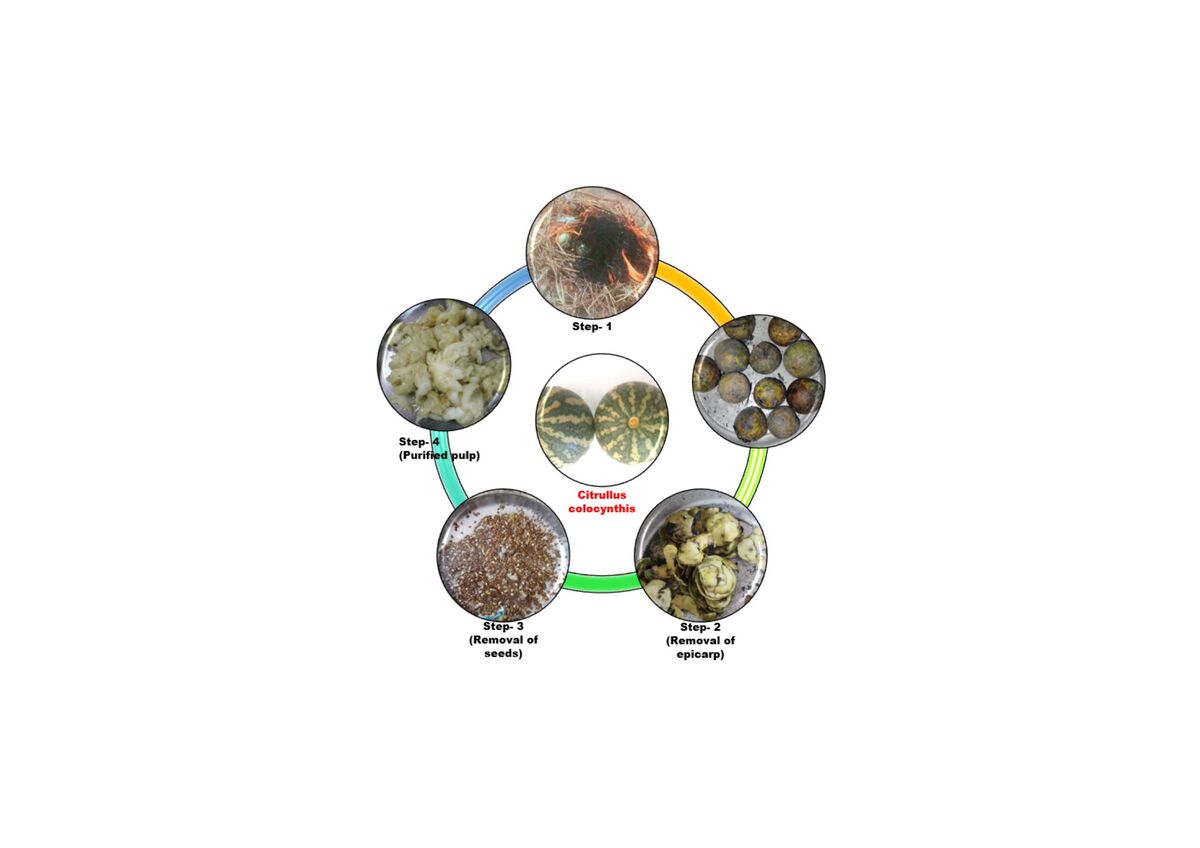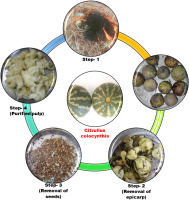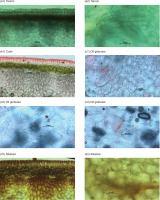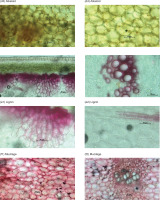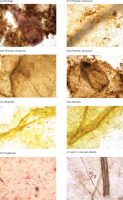1. INTRODUCTION
Citrullus colocynthis (L.), commonly known as bitter apple or desert gourd, is a medicinal plant widely used in traditional medicine for its potent therapeutic properties. It is rich in bioactive compounds such as cucurbitacins, flavonoids, and alkaloids contributing to its pharmacological activities, including anti-inflammatory, antimicrobial, and antidiabetic effects (Rahimi et al., 2012). The Drugs and Cosmetics Act classifies C. colocynthis (L.) as a Schedule E drug due to its potent medicinal properties and potential toxicity (Juliet et al., 2021). In Siddha medicine, this plant, commonly known as kalingam or varithumatti, is traditionally used for treating vata disorders, menorrhagia, amenorrhea, and uterine disorders. C. colocynthis (L.), while beneficial in treating digestive disorders, joint pain, and skin diseases, must be used with caution to avoid adverse effects such as severe gastrointestinal irritation (Espinosa et al., 2022; Murugesamudhaliyaar, 2013). However, the raw form of C. colocynthis (L.) is known for its intense bitterness and potential toxicity, necessitating purification processes to enhance its safety and efficacy. The formulations containing C. colocynthis (L.) in Siddha medicine are recommended only after purification. The process of purification is traditionally employed to reduce toxicity and improve the bioavailability of its active constituents. The preliminary study of changes taking place during purification was assessed using physicochemical and pharmacognostic histochemical evaluation.
Pharmacognosy, the study of medicinal drugs derived from natural sources, plays a crucial role in analyzing the structural, physical, and chemical characterization, including isolation, identification, and quantification, of drug plant constituents (Alamgir, 2017). Histochemistry identifies and analyzes chemical distribution in biological cells using stains, indicators, and electron microscopy. It enables chemical characterization while preserving structural organization. In plant secretory structures, a detailed analysis is essential, as glands and cells can produce multiple metabolites simultaneously (Badria and Aboelmaaty, 2019).
Of interest here is to examine the pharmacognostical variations of C. colocynthis (L.) before and after purification, focusing on alterations in physicochemical and histochemical constituents. Understanding these transformations during the purification of C. colocynthis (L.) is essential for optimizing its therapeutic applications while ensuring its safety for medicinal use.
2. MATERIALS AND METHODOLOGY
2.1. Identification and authentication
The fruit of C. colocynthis (L.) was collected from Karunkulam, Tirunelveli district, during the spring season. The identification and authentication were done at the Department of Pharmacognosy, Siddha Central Research Institute, Arumbakkam, Chennai. The authentication code is C14072301C. The dried straw of Paspalum scrobiculatum L. (kodo millet) was authenticated at the Department of Medicinal Botany, National Institute of Siddha, Chennai. The authentication code is NISMB6472024.
2.2. Purification method
The purification process of C. colocynthis (L.) fruit was done after obtaining authentication. Then it was burned with the straw of kodo millet (varagu vaikkol) until soft, after which its outer layer of the peel and seeds were removed. After that, the pulp was collected and properly stored. This pulp was used for medicine preparation (Figure 1) (Juliet et al., 2021; Murugesamudhaliyaar, 2013). The two samples used for analysis were raw unpurified and purified C. colocynthis (L.) pulp.
2.3. Organoleptic characterization
The organoleptic characterization of C. colocynthis (L.) was carried out in line with the Pharmacopoeial Laboratory for Indian Medicine (PLIM) guidelines. The physical state of the samples was identified through direct visual inspection. For this, 5 g of each sample—unpurified and purified C. colocynthis (L.) pulp—were placed in clean glass containers and visually assessed for color. Each sample was then transferred to a separate beaker, where its odor was analyzed (Lohar, 2008; Ministry of Ayush, 2018).
2.4. Physicochemical analysis
The physicochemical parameters—including potential of hydrogen (pH), loss on drying (LOD) at 105°C, total ash content, water-soluble ash, and acid-insoluble ash as well as water and alcohol-soluble extractive values—were evaluated for both unpurified and purified pulp of C. colocynthis (L.) in accordance with PLIM guidelines (Lohar, 2008; Ministry of Ayush, 2018). These tests were analyzed in the Department of Chemistry at the Siddha Central Research Institute, Arumbakkam, Chennai.
2.5. Pharmacognostic study of histochemical analysis
Fruit sections were treated according to the standard procedures outlined in Table 1 (Fahn, 1980; Khandelwal, 2008; Wallis, 1965).
Table 1
Procedures for histochemical analysis.
3. RESULTS AND DISCUSSION
The organoleptic characteristics of C. colocynthis before and after purification are presented in Table 2. The physicochemical parameters of unpurified and purified C. colocynthis (L.) pulp are provided in Table 3. The histochemical analysis of C. colocynthis before purification is shown in Table 4 and Figure 2, while the histochemical analysis after purification is presented in Table 5 and Figure 3.
Table 2
Organoleptic characteristics of Citrullus colocynthis before and after purification.
Table 3
Physicochemical parameters of unpurified and purified Citrullus colocynthis (L.) pulp.
Table 4
Histochemical analysis of Citrullus colocynthis before purification.
Table 5
Histochemical analysis of Citrullus colocynthis (L.) after purification.
| Epicarp region | - |
|---|---|
| Mesocarp region |
Observed through histochemical characterization, the purification process of C. colocynthis (L.) significantly alters its physical and chemical properties. The organoleptic evaluation revealed distinct changes in the pulps color, texture, and consistency. Before purification, the pulp exhibited a greenish-white hue, a hard texture, and a smooth surface. After purification, these attributes transformed, resulting in a dull white, softer, and more succulent pulp. Despite these physical changes, the characteristic bitter odor and taste remained unaltered, indicating the persistence of certain phytochemical constituents even after purification. The increased succulence in the purified pulp is attributed to its substantial mass content, which constitutes nearly half of the total fruit mass (Rao and Poonia, 2023).
The pH level plays a vital role in assessing the quality of medicinal formulations, as it influences both chemical reactions and microbial activity. In this study, the pH of unpurified C. colocynthis pulp was 5.23, which slightly dropped to 4.82 after purification, indicating an increase in acidity. According to Allen (2003), herbal formulations with a low pH, due to the presence of acidic compounds, tend to have reduced bacterial counts. Conversely, higher or neutral pH values can support microbial growth. Optimal bacterial proliferation in medicinal products typically occurs within a pH range of 5.0–8.5. Therefore, the lower pH of the purified pulp may help inhibit microbial growth, making it more suitable for medicinal applications (Allen, 2003; Kumadoh et al., 2024). The moisture content, measured as LOD, was 92.035% in unpurified pulp and slightly increased to 92.935% in the purified sample. This rise may result from the removal of solids or breakdown of complex molecules during processing, allowing the pulp to retain more water. Given that C. colocynthis inherently contains more than 90% moisture, this increase is consistent with its natural composition; moisture also contributes to elevated absorption values (Hussain et al., 2014; Ibrahim et al., 2021). The total ash content, representing the inorganic matter in the sample, decreased significantly from 4.515% in the unpurified pulp to 2.39% after purification. This decline suggests that the purification process effectively removes a considerable portion of the mineral content. The low ash levels also indicate reduced contamination in the purified sample. Water-soluble ash, a fraction of the total ash that dissolves in water, was reduced from 3.395% to 1.85% post-purification. This reduction suggests that some water-soluble minerals or salts are eliminated during processing. Acid-insoluble ash, which indicates the presence of insoluble impurities such as silica, also decreased from 0.701% to 0.395%, confirming the removal of such contaminants through purification (Prakash et al., 2019).
Extractive values are used to determine and measure the chemical components that dissolve in certain solvents (Prakash et al., 2019). In the unpurified pulp, the water- and alcohol-soluble extractive values were 4.37% and 3.965%, respectively, which dropped to 2.26% and 2.415% after purification. This overall decline reflects a reduction in chemical constituents, likely due to the effects of heat processing. Prior studies have also reported that such processing leads to the breakdown of active components. The pulp primarily contains cucurbitane-type triterpene glycosides, along with triterpene saponins, phenolic acids, and flavonoids. The observed decrease in extractive values suggests that these glycosides may be converted into their corresponding genins during purification (Darwish et al., 2021). The histochemical analysis of C. colocynthis (L.) pulp before and after purification has revealed significant alterations in its phytochemical composition of cells and tissues. One of the most notable findings was the presence of cutin on the epicarp walls in the unpurified pulp, which was absent in the purified pulp. Cutin, a protective waxy layer, serves as an effective barrier against water loss through transpiration, particularly in desert plants like C. colocynthis (Ladaniya, 2008). Therefore, this cutin deficiency after purification led to an increased proportion of hydrophilic constituents, contributing to a more succulent nature (Isaacson et al., 2009).
Tannins, which were found in the mesocarp of the unpurified pulp but not in the purified pulp, are polyphenolic compounds known for their astringent properties. While tannins offer a range of beneficial effects, such as antioxidant and antimicrobial properties, they are also associated with potential antinutritional effects. Tannins can inhibit the bioavailability of essential nutrients, such as vitamins and minerals, and interfere with enzymatic activity. The absence of tannins in the purified pulp potentially improves the bioavailability of vitamins such as B12 and D (Sharma et al., 2019). Lignin, an essential component of the plants vascular system, was detected in the xylem strands and stone cells of the unpurified pulp. However, in the purified pulp, lignin was only found in the xylem of vascular strands, with no presence in the stone cells. Lignin is crucial for water conduction and structural support within the plant, and its selective removal from stone cells may imply changes in the mechanical properties and succulence of the pulp (Encyclopedia Britannica, 2025).
Both the unpurified and purified pulp contained mucilage, which was identified in the phloem cells and mesocarp parenchyma. Mucilage plays a vital role in water retention, seed dispersal, and potentially in the production of nanocarriers for pharmaceutical applications. Its persistence in both unpurified and purified pulp suggests that mucilage remains unaffected by the purification process, maintaining its functional properties in both forms of the pulp (Tosif et al., 2021). The presence of alkaloids in both the epicarp and mesocarp cells of the unpurified and purified pulp highlights the presence of bioactive compounds that may have pharmacological or toxic effects. Alkaloids, known for their diverse range of biological activities, could either contribute to the fruits medicinal properties or pose toxicity risks (Zheng et al., 2020). Oil globules, detected in the parenchyma cells of both unpurified and purified pulp, indicate the storage of lipids, which are important for energy provision and may also contribute to the fruits potential therapeutic properties. The preservation of oil globules in the purified pulp suggests that lipid content is not significantly altered during processing, which could be beneficial for maintaining the nutritional value of the fruit (Kalebar et al., 2019).
Phenolic compounds, which were detected only in the purified pulp, are known for their antioxidant properties. The increase in phenolic content following purification enhances the potential health benefits of C. colocynthis pulp, providing an additional mechanism for disease prevention and health promotion. The purification process enhances phenolic compounds, indicating antioxidant capacity of the pulp (Minatel et al., 2017). Starch grains, absent in the purified pulp, suggest that starch degradation occurred during the purification process, leading to a softening of the pulp. This change in texture could be due to the breakdown of starch into simpler sugars, making the fruit more easily digestible and possibly altering its glycemic index (Xiao et al., 2018). Resins, which are metabolic by-products of plant tissues, consist of a combination of volatile and nonvolatile terpenoid and/or phenolic secondary compounds, along with fatty substances that naturally exude from plants (McCreath and Clement, 2024). Cucurbitacins, a group of triterpenoids, are the main active compounds found in C. colocynthis (L.), known for their bitter taste and potential toxicity (Barton et al., 1999; Cheng et al., 2023). The absence of resins in the purified pulp suggests that these compounds, which may have influenced the potential medicinal properties, either eliminated or broken down during processing. The removal or degradation of potentially harmful compounds like tannins, cutin, and resins, along with the enhancement of bioactive components such as phenolics, could make the purified pulp a more beneficial and less toxic option for consumption. The preservation of beneficial compounds like mucilage, alkaloids, oil globules, and lignin in specific tissue types suggests that the purification process selectively alters the fruits chemical composition without completely removing its functional components. These findings illuminate the potential for using purification techniques to improve the therapeutic potential of C. colocynthis (L.) pulp.
4. CONCLUSION
The histochemical localization of various phytochemicals in the pulp of C. colocynthis (L.) before and after purification reveals notable alterations in its physical and chemical characteristics, enhancing its usability and therapeutic value by minimizing toxic effects. The comprehensive organoleptic, physicochemical, and histochemical analyses aid in precise identification and standardization of the fruit, forming a basis for future pharmacological investigations. This preliminary assessment documents the transformations occurring through purification, offering valuable insights into its pharmacognostic features. The distribution of phytochemicals within the fruit tissues supports its traditional application in treating various conditions, underscoring the significance of C. colocynthis (L.) in both Siddha medicine and contemporary pharmacognosy.


